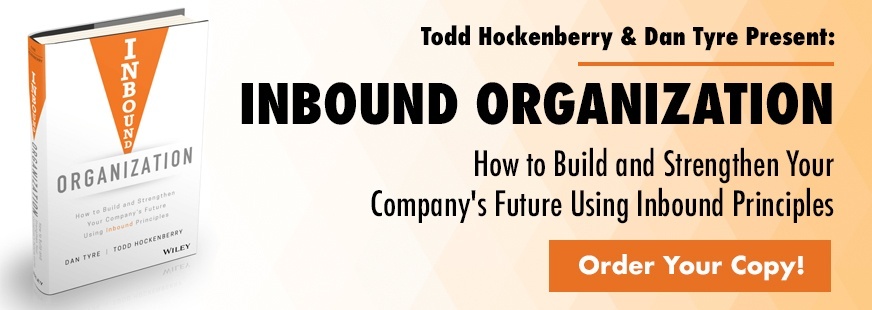Guest Blog by Todd Hockenberry, of Top Line Results and co-author of Inbound Organization
In Part 1 in this series we discussed how to build a predictable revenue stream for manufacturing companies.
In Part 2 we discussed how connecting with buyers by being helpful is the key to creating a remarkable customer experience and is the next step once a customer focused mission, culture, and messaging are in place.
In Part 3, Align Marketing, Sales, and Service to Make Connections with Buyers, we discussed the need to have a focused and customer oriented customer facing team.
In Part 4, What Inbound Organizations Do, Deliver A Great Customer Experience we reviewed the result, the outcome for your customer, when you follow these steps.
In this article, Customer Success, we talk about how to grow your business with your existing customers.
 Where should new revenue growth come from?
Where should new revenue growth come from?
Where should most of your new revenue come from? When asked that question industrial executive almost always say from net new customer acquisition. Growth is tied to generating new business from new customers.
And this makes sense. Marketing and sales leaders control the experience they deliver. They build sales processes and follow tried and true sales methodologies. You build playbooks and charts and funnels and deal stages and track these in your CRM. These become the repeatable steps on the road to revenue.
How many of you follow this level of process and methodology for after the customer has your product? There are two outcomes for your customers: they achieve the goals they expected to reach when they bought from your company or they don’t.
You know they will hit roadblocks along the way and your service team is there to react when they call. But is this enough in today’s age of buyer control? Is this the type of experience buyers today want?
As we have been defining the Inbound Organization lets spell out the difference between service and success.
Customer service means reacting promptly to all requests and solving the immediate issues customers have.
Customer success is the proactive application of a process to ensure customers see long-term value from your products and services and benefit from using your solutions.
These are not the same and they should be separate functions within your company.
Customer Success Stages
Just like the sales process there is a customer success process with defined stages.
Activation
These are the very first interactions a buyer has with your product or service. This is the initial hand off from sales to after-sales activities and could include setup, login, installation, run off, and training. This transition is critical because like any relationship getting off on the right foot is critical to long term success.
Day Zero
This is the moment when a customer reaches the point that they start to realize the full value of the product or service purchased in terms of the job they hired it to do. Depending on your product the time to this stage could be short - an app just downloaded or long - an enterprise ERP system. Day zero is the transition from startup to valuable usage.
Time to Value
This stage sees customers receiving value and beginning to reach their goals.
Value Loop
This loop happens when customers realize they are being successful with your solution and are open to new ideas about other areas to receive value and the potentially solve more problems and reach more goals and strategic objectives with you. A value loop ends when the customer buys another solution from your company whether as a standalone or add-on to existing products or services.
The goal of customer success is to methodically track, monitor, and support customers as they strive to reach their goals. There’s no guarantee they’ll achieve what they want to achieve with your product or service unless you make sure they do.
Doing this gives your company unique opportunities to grow revenue at a much low cost than investing in net new revenue. The old cliche that it costs seven times more to get a new customer than it is to keep an existing one certainly still holds true.
In fact, today’s lost customer is one that shares their experiences online and makes it that much harder to get those net new customers which means the multiple of cost is almost certainly higher than 7x.
 Align Service and Success with Marketing and Sales
Align Service and Success with Marketing and Sales
Smarketing (aligning marketing and sales) is a start but this effort alone becomes mostly about generating net new customers. Service and Success teams needs to be aligned with the marketing and sales teams. Service is a big part of the buyer journey and must be a revenue generator because retaining customers is more important than ever in the age of buyer control and intense competition.
Sales/Marketing people have to have customer success in mind right from the beginning of the process, hence the need for complete team alignment.
Marketing and sales teams must:
- Identify the right ideal companies
- Identify a persona/s who buys your solutions
- Make hard decisions regarding customer/persona fit - qualify
- Meet prospects where they are today
- Leverage lead intelligence and lead notifications across the buyer journey
- Share the buying process details with customer service and success
- Customer service needs to review and evaluate the sales process notes (must have a CRM)
- Customer service needs to communicate with the rest of the organization the key outcomes and issues customers face
Two key metrics that drive strategic success are cost of customer acquisition and lifetime customer value. Adopting a customer success model and investing in a team to manage customers achievement of their goals results in lover cost of customer/revenue acquisition and increases lifetime customer value. Both results that should get senior leaders attention.
Focus on Customer Success to Grow
Goal of the customer facing teams (and in fact the entire company) is delivering an exceptional customer experience, which leads to customer success. Customer success builds loyalty expands your opportunity to help your customers.
This is a giant opportunity for your business. No one is in a better position to help your customers reach their strategic goals than you are. No one has more insight and information than you do. And no one has more to lose by getting the customer experience wrong than you do.





